MC9S08EL16CTJ Freescale Semiconductor, MC9S08EL16CTJ Datasheet - Page 201

MC9S08EL16CTJ
Manufacturer Part Number
MC9S08EL16CTJ
Description
MCU 16KB FLASH SLIC 20TSSOP
Manufacturer
Freescale Semiconductor
Series
HCS08r
Datasheet
1.DEMO9S08EL32.pdf
(356 pages)
Specifications of MC9S08EL16CTJ
Core Processor
HCS08
Core Size
8-Bit
Speed
40MHz
Connectivity
I²C, LIN, SCI, SPI
Peripherals
LVD, POR, PWM, WDT
Number Of I /o
16
Program Memory Size
16KB (16K x 8)
Program Memory Type
FLASH
Eeprom Size
512 x 8
Ram Size
1K x 8
Voltage - Supply (vcc/vdd)
2.7 V ~ 5.5 V
Data Converters
A/D 12x10b
Oscillator Type
External
Operating Temperature
-40°C ~ 85°C
Package / Case
20-TSSOP
Processor Series
S08EL
Core
HCS08
Data Bus Width
8 bit
Data Ram Size
1 KB
Interface Type
SCI, SPI, I2C, SLIC
Maximum Clock Frequency
200 KHz
Number Of Programmable I/os
16
Number Of Timers
2
Operating Supply Voltage
5.5 V
Maximum Operating Temperature
+ 85 C
Mounting Style
SMD/SMT
3rd Party Development Tools
EWS08
Development Tools By Supplier
DEMO9S08EL32AUTO, DEMO9S08EL32
Minimum Operating Temperature
- 40 C
On-chip Adc
10 bit, 12 Channel
For Use With
DEMO9S08EL32 - BOARD DEMO FOR 9S08 EL MCUDEMO9S08EL32AUTO - DEMO BOARD EL32 AUTO
Lead Free Status / RoHS Status
Lead free / RoHS Compliant
- Current page: 201 of 356
- Download datasheet (9Mb)
12.3.7
The SLIC identifier (SLCID) and eight data registers (SLCD7–SLCD0) comprise the transmit and receive
buffer and are used to read/write the identifier and message buffer 8 data bytes. In BTM mode (BTM = 1),
only SLCID is used to send and receive bytes, as only one byte is handled at any one time. The number of
bytes to be read from or written to these registers is determined by the user software and written to
SLCDLC. To obtain proper data, reads and writes to these registers must be made based on the proper
length corresponding to a particular message. It is the responsibility of the user software to keep track of
this value to prevent data corruption. For example, it is possible to read data from locations in the message
buffer which contain erroneous or old data if the user software reads more data registers than were updated
by the incoming message, as indicated in SLCDLC.
The first data byte received after the LIN identifier in a LIN message frame will be loaded into SLCD0.
The next byte (if applicable) will be loaded into SLCD1, and so forth.
The SLIC identifier register is used to capture the incoming LIN identifier and when the SLCSV value
indicates that the identifier has been received successfully, this register contains the received identifier
value. If the incoming identifier contained a parity error, this register value will not contain valid data.
In byte transfer mode (BTM = 1), this register is used for sending and receiving each byte of data. When
transmitting bytes, the data is loaded into this register, then TXGO in SLCDLC is set to initiate the
transmission. When receiving bytes, they are read from this register only.
Freescale Semiconductor
Reset
W
R
SLIC Identifier and Data Registers (SLCID, SLCD7-SLCD0)
An incorrect length value written to SLCDLC can result in the user software
misreading or miswriting data in the message buffer. An incorrect length
value might also result in SLIC error messages. For example, if a 4-byte
message is to be received, but the user software incorrectly reports a 3-byte
length to the DLC, the SLIC will assume the 4th data byte is actually a
checksum value and attempt to validate it as such. If this value doesn’t
match the calculated value, an incorrect checksum error will occur. If it does
happen to match the expected value, then the message would be received as
a 3-byte message with valid checksum. Either case is incorrect behavior for
the application and can be avoided by ensuring that the correct length code
is used for each identifier.
R7
T7
0
7
MC9S08EL32 Series and MC9S08SL16 Series Data Sheet, Rev. 3
R6
T6
6
0
Figure 12-11. SLIC Identifier Register (SLCID)
R5
T5
0
5
NOTE
R4
T4
4
0
R3
T3
0
3
R2
T2
2
0
R1
T1
0
1
R0
T0
0
0
203
Related parts for MC9S08EL16CTJ
Image
Part Number
Description
Manufacturer
Datasheet
Request
R
Part Number:
Description:
Manufacturer:
Freescale Semiconductor, Inc
Datasheet:
Part Number:
Description:
Manufacturer:
Freescale Semiconductor, Inc
Datasheet:
Part Number:
Description:
Manufacturer:
Freescale Semiconductor, Inc
Datasheet:
Part Number:
Description:
Manufacturer:
Freescale Semiconductor, Inc
Datasheet:
Part Number:
Description:
Manufacturer:
Freescale Semiconductor, Inc
Datasheet:
Part Number:
Description:
Manufacturer:
Freescale Semiconductor, Inc
Datasheet:
Part Number:
Description:
Manufacturer:
Freescale Semiconductor, Inc
Datasheet:
Part Number:
Description:
Manufacturer:
Freescale Semiconductor, Inc
Datasheet:
Part Number:
Description:
Manufacturer:
Freescale Semiconductor, Inc
Datasheet:
Part Number:
Description:
Manufacturer:
Freescale Semiconductor, Inc
Datasheet:
Part Number:
Description:
Manufacturer:
Freescale Semiconductor, Inc
Datasheet:
Part Number:
Description:
Manufacturer:
Freescale Semiconductor, Inc
Datasheet:
Part Number:
Description:
Manufacturer:
Freescale Semiconductor, Inc
Datasheet:
Part Number:
Description:
Manufacturer:
Freescale Semiconductor, Inc
Datasheet:
Part Number:
Description:
Manufacturer:
Freescale Semiconductor, Inc
Datasheet:










